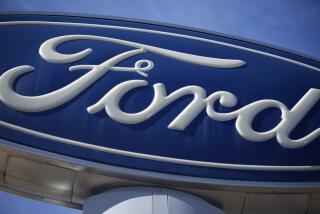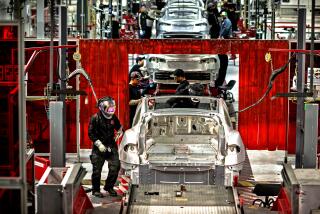Ford to Cut 35,000 Jobs, Shutter Five Factories
DEARBORN, Mich. — Attempting to reverse its sudden fall from prosperity, Ford Motor Co. said Friday that it will cut 35,000 jobs around the world, close five North American factories and discontinue four models, including the storied Lincoln Continental.
The world’s second-largest auto maker hopes the draconian moves will help it recover from myriad problems of the last year, including quality lapses, a slide in productivity, loss of market share to its major competitors and eroded profit. The Firestone tire recall, for example, cost Ford billions, and its last four new models to be launched all were recalled numerous times or delayed because of quality glitches.
The plants to be closed beginning in 2003 are the Edison truck plant in New Jersey, which makes Ranger pickups; the Ontario truck plant in Canada, which produces F-series pickups; the St. Louis assembly plant, which produces Explorer sport-utility vehicles; Cleveland Aluminum Casting; and Vulcan Forge in Dearborn, which produces engine parts that soon will be obsolete.
The closings will reduce Ford’s production capacity by about 900,000 vehicles, from 5.7 million to 4.8 million. The massive job cuts include 22,000 positions in North America. Of the 35,000 total cuts, about 15,000 previously had been announced.
In addition to phasing out the luxury icon Continental, Ford said it will discontinue the low-profit-margin Ford Escort, Mercury Cougar coupe and Villager minivan as part of a plan to realize $9 billion in profit improvement by the middle of the decade.
“It’s a comprehensive plan, but not a magic wand,” Chief Executive William Clay Ford Jr. told more than 300 industry analysts and journalists in this Detroit suburb, where Ford is headquartered.
The program “is based on executing the fundamentals of our business to build great products. It’s going to take everyone in the extended Ford family--employees, suppliers and dealers--working together, over time, to make it work,” Ford said, standing under a huge sign that read Corporate Revitalization Plan.
Ford, the 44-year-old great- grandson of company founder Henry Ford who has been chief executive for only 10 weeks, said he will forgo his salary in 2002 and perhaps in 2003, until Ford turns around.
Ford and President and Chief Operating Officer Nick Scheele expressed regret at the measures taken, especially the five plant closures. In addition, no new products have been assigned to two other plants: Ohio Assembly, which produced the Villager and the Nissan Quest minivans, and Cuautitlan Assembly in Mexico, which builds smaller vehicles primarily for the Mexican market. Eleven other factories will see major downsizing and shift reductions, and nine plants will undergo line-speed reductions to limit output.
Ford cannot close any U.S. factory until after the current labor contract with the United Auto Workers ends in September 2003. The UAW was informed before Friday’s announcement but has little leverage to stop Ford from carrying out its plans.
The UAW issued a statement claiming credit for maintaining union jobs in tight times.
“Because of our contract, Ford has been required to plan its restructuring in a way that respects the seniority rights--including job placement rights, income, pension, health care and many other protections of UAW-Ford members,” said UAW Vice President Ron Gettelfinger.
“Although the actions we’re outlining today are difficult, they are necessary steps to lead Ford back to a strong financial and competitive position,” Scheele said.
First and foremost, Ford must improve its vehicle quality, Scheele said, noting that Ford slipped to seventh place among the top seven auto makers in initial quality, according to May’s quality report by J.D. Power & Associates. He pledged to improve on that by the time the next J.D. Power report is released.
Ford lost $692 million in the second and third quarters of 2001 and is expected to finish the year about a billion dollars in the red. The first quarter of 2002 is expected to be the toughest, with subsequent quarters showing gradual improvement, Chief Financial Officer Martin Inglis said.
Analysts, in general, applauded Ford’s moves.
“It goes a lot deeper than I had expected,” said Burnham Securities auto industry analyst David Healy. “I think the long-term results, for that reason, will probably be greater and the near-term effects are unfavorable. The company is looking at no better than break-even for 2002 despite the $2 billion in savings.
“Ford probably has gotten most of its bad news out of the way,” Healy said. “They’ve written off everything and taken provisions for everything they can see currently to get back to a solidly profitable position in a couple of years.”
But Saul Rubin, auto analyst with UBS Warburg, said it was just a beginning.
“I think they are going to have to go beyond the plans they’ve laid out today. This is just stage one of what will have to be a multistage program,” Rubin said. Ford needs to do “more of the same” to reach and sustain profitability, including additional personnel and capacity cuts, he said.
Ford shares rose 21 cents to close at $15.50 on Friday on the New York Stock Exchange after sinking $1.02 on Thursday in advance of the restructuring plan.
But two credit rating agencies, Standard & Poor’s and Fitch, said Friday that they are cutting their credit ratings on Ford and its financing arm, Ford Credit, citing the auto maker’s weak profit, shrinking market share and deteriorating liquidity.
The company said it will take a $4.1-billion charge against fourth-quarter earnings. Ford also will reduce its dividend for the second quarter in a row, from 15 cents to 10 cents, after cutting it from 30 cents in the second quarter, sell non-core assets amounting to a billion dollars this year and work with suppliers to reduce material costs.
Ford also said Friday that it will offer $2,500 rebates and continue its interest-free loan offers on certain vehicles as it counters costly incentives from General Motors and Chrysler Group.
Of the four vehicles Ford is eliminating, none is a big seller, and the company had said it will end production of the Mercury Villager and the Ford Escort, which has been replaced by the Focus. Speculation about the impending death of the Continental and Cougar brands began spreading in earnest last summer.
Eliminating model names isn’t unusual. They often are retired for a year or two, then brought back on redesigned vehicles.
The Cougar name, for example, originated in 1967 on a Mercury version of the Ford Mustang and remained in use through the 1997 model year. It was resurrected in 1999 on what Mercury hoped would be a competitor in the import-dominated sports coupe segment. But the new Cougar never became a contender.
Lincoln retired the Continental once before, but by eliminating it again it ends the reign of the second-oldest continuously used passenger car model name in the U.S. auto industry. Corvette and Eldorado, introduced on GM cars in 1953, are the oldest.
The Continental name initially was used on a 1941 Lincoln Zephyr and was retired in 1948 when Lincoln redesigned its entire lineup. It was reintroduced in 1956 on the Continental Mark II and has been part of the Lincoln line since. Perhaps the most famous Continentals were the slab-sided models with center-opening doors made in the 1960s; President Kennedy was riding in one when he was assassinated in 1963.
Mercury, which loses two models, remains a moneymaker for Ford, and Irvine-based Lincoln Mercury President Brian Kelly insists that the marque is here to stay. Indeed, Mercury is developing a replacement for the Villager, an all-new minivan expected to be launched in 2004.
As if to underscore the company’s commitment to Mercury, William Ford’s cousin Elena Ford was recently assigned to Irvine as group brand manager for Mercury. “I like my cousin,” Ford told The Times at lunch. “I didn’t set her up.”
*
Times staff writer John O’Dell in Los Angeles contributed to this report.






